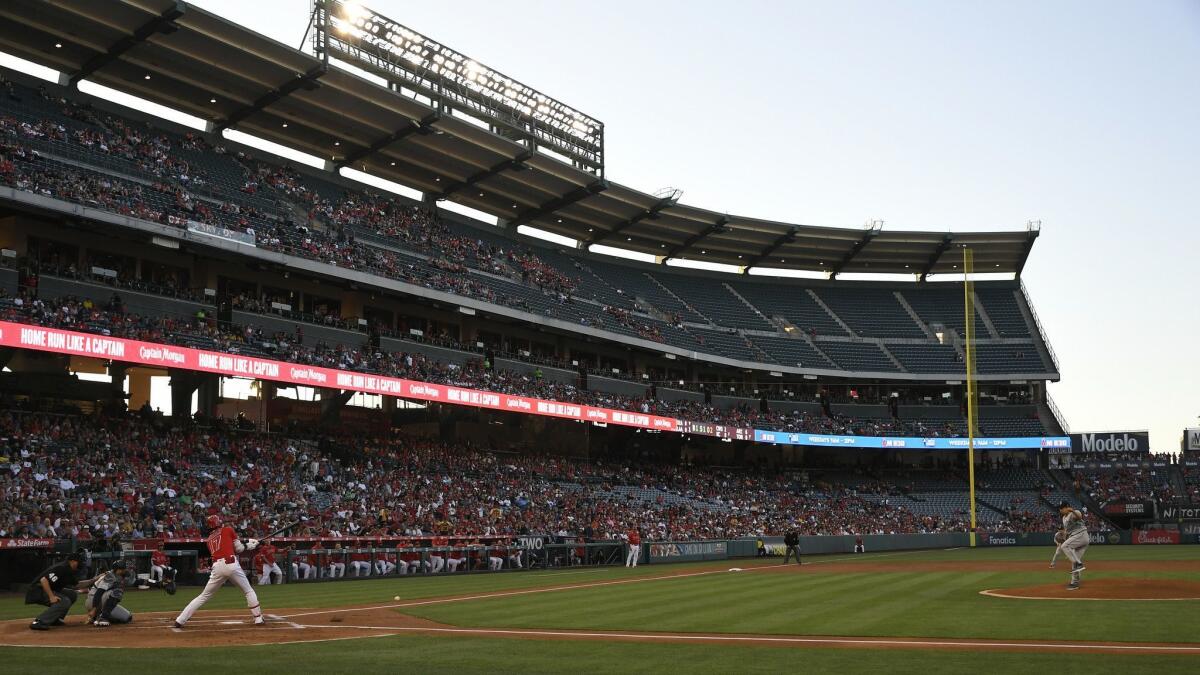L.A. doesn’t pay to build sports stadiums, but billions are generated from them anyway

- Share via
On April 19, 1966, the Angels played their first regular-season game in the stadium the city of Anaheim built for them. They lost. The winning pitcher for the visiting Chicago White Sox was Tommy John, eight years before he lent his elbow to the surgery that now carries his name.
More than half a century later, Angel Stadium stands as the last taxpayer-financed facility built for a major sports franchise in Los Angeles and Orange counties.
Outside of California, teams routinely persuade local governments to throw hundreds of millions of public money toward stadiums and arenas, even as the teams keep most of the revenue generated by those venues. Without those subsidies, the teams argue, those localities would lose out on the significant economic impact generated by all those games.
In 2018, the sports industry in Los Angeles and Orange counties generated $6.2 billion in economic impact and $327 million in taxes for state and local governments, according to a study scheduled to be released Monday by the Los Angeles Sports Council. The bottom line: a healthy one for the teams, and for the cities in which they play.
“Los Angeles has broken the mold,” the report states.
The Sports Council partners with local teams and cities in bidding for major sporting events. As the region ramps up for a run of those events — including baseball’s All-Star game next year, the Super Bowl in 2022, the national college football championship in 2023, the World Cup in 2026, and the Olympic Games in 2028 — the Sports Council commissioned the report to show the formidable foundation of the Southland’s sports business.
“We felt now was the perfect time to quantify the growing impact sports has in our economy,” said Sports Council president David Siegel. “One of the things we love about sports is how it touches people from an emotional standpoint. But I think — outside of player salaries, which are pretty up front and in your face — the economic impact it has on our community and in our daily lives is lost.”
The regional sports industry generates 40,000 jobs, according to the study, which was conducted by the Los Angeles Economic Development Corporation (LAEDC). The figure includes full-time and part-time jobs with major and minor league teams, college athletic departments and special event promoters; jobs serving the needs of those organizations; and jobs created when employees of those organizations spend their salaries in the community.
In Los Angeles County alone, the total workforce is 5 million, according to the LAEDC. The film industry generates $64 billion in annual economic impact.
“If you look at the larger employers, it kind of dwarfs sports,” said Somjita Mitra, director of the LAEDC Institute for Applied Economics.
Sign up for our daily sports newsletter »
In addition, a substantial number of sports industry jobs are game-day employees, working irregular part-time shifts selling hot dogs, T-shirts and parking spaces. The Angels’ staff directory, for instance, lists fewer than 300 full-time employees based in Anaheim.
As the Angels explore whether to stay in Anaheim — in a new or renovated stadium — or consider a potential waterfront ballpark in Long Beach, neither city is expected to offer a slice of its general fund for stadium construction.
Long Beach is considering an option to pay for ballpark construction by diverting taxes generated by a stadium district, rather than collecting them for city services, including police, libraries and parks. Anaheim is considering whether to let the Angels develop the stadium parking lot.
Either scenario reflects another sentiment commonly pitched by teams: build a venue, and economic development — restaurants, shops, hotels and such — inevitably will surround the venue. That is far from a slam-dunk argument for a subsidy, Mitra said.
“The sports industry’s existence here isn’t necessarily going to attract other investment,” Mitra said. “And there are going to be some investments with or without the team there. To the extent that the team itself would solely be responsible for it? That would be hard to measure.”
Nationally, teams remain active in soliciting taxpayer funding for their venues. The NFL’s Charlotte Panthers got more than $100 million from South Carolina toward building a practice facility and team headquarters — even though the stadium will remain in North Carolina. The NHL’s Arizona Coyotes would like Arizona taxpayers to consider a new arena for them. Baseball’s Tampa Bay Rays would like Florida taxpayers to consider a new ballpark for them — and might play half their games in Montreal even if they get it.
“For sports, it’s not a very logical industry,” Mitra said. “It’s driven by passion and sentiment and civic engagement. It’s hard for people to sort that out from the purely economic terms.”
When Angel Stadium underwent a $117-million renovation in 1996, the Walt Disney Co. — then the owner of the Angels — paid $97 million of the cost. The major pro sports venues to open since then — Staples Center, Dignity Health Sports Park (the former StubHub Center) and Banc of California Stadium — were privately financed.
So was Dodger Stadium, and it opened in 1962. The Dodgers’ current owners have invested about $200 million into Dodger Stadium renovations, with additional upgrades expected before next year’s All-Star game.
And, when Rams owner Stan Kroenke brought the NFL back to Los Angeles, he arranged the financing for the $3-billion stadium scheduled to open next year.

Rams rookies received a tour of the new stadium in Inglewood that they will share with the Chargers beginning in the 2020 season.
Siegel, the Sports Council president, said he was unaware of any local team experiencing financial distress in the absence of major taxpayer subsidies.
He said that what works here might not necessarily work elsewhere — the Los Angeles market is the second-largest in the United States — but said the study depicted “a great narrative and a great case study for other cities to look at.”
The Rams left the Southland after the 1994 season because St. Louis threw public money at them. The NFL did not return until 2016, because the Southland did not care to throw public money at the league. The regional economy, according to the LAEDC study, still benefited from plenty of impact.
Said Mitra: “People come here because it’s L.A. They come here because it’s Orange County. For Stan Kroenke to come here, he knew that there is no public sentiment here to support higher taxes for a stadium. The benefits of being here far outweigh his personal cost.
“There is a lesson. Whether other areas listen to it, I can’t say. It’s hard, especially when you start saying, ‘If you don’t build it, our team is going to leave,’ and people might be a little more passionately involved in trying to keep the team.”
Follow Bill Shaikin on Twitter @BillShaikin
More to Read
Go beyond the scoreboard
Get the latest on L.A.'s teams in the daily Sports Report newsletter.
You may occasionally receive promotional content from the Los Angeles Times.











